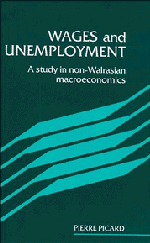Book contents
- Frontmatter
- Contents
- Acknowledgements
- Introduction
- 1 Price rigidities and temporary equilibrium
- 2 Wage rigidity and short-run macroeconomic equilibrium
- 3 Real wages and the inflation—unemployment dilemma
- 4 External constraint, oil shock and economic policy
- 5 Implicit contracts and unions
- 6 Introduction to efficiency wage models
- 7 Efficiency wages, employment fluctuations and fiscal policy
- 8 Labour market dualism, efficiency wages and optimal taxation
- Notes
- References
- Author index
- Subject index
3 - Real wages and the inflation—unemployment dilemma
Published online by Cambridge University Press: 28 October 2009
- Frontmatter
- Contents
- Acknowledgements
- Introduction
- 1 Price rigidities and temporary equilibrium
- 2 Wage rigidity and short-run macroeconomic equilibrium
- 3 Real wages and the inflation—unemployment dilemma
- 4 External constraint, oil shock and economic policy
- 5 Implicit contracts and unions
- 6 Introduction to efficiency wage models
- 7 Efficiency wages, employment fluctuations and fiscal policy
- 8 Labour market dualism, efficiency wages and optimal taxation
- Notes
- References
- Author index
- Subject index
Summary
The relationship between inflation and unemployment has been one of the most recurrent themes in the neo-Keynesian macroeconomic literature. In elementary Keynesian models, inflation may result from excess aggregate demand, that can be controlled through manipulating short-run fiscal and monetary policies, thus allowing the avoidance of both alternating disequilibria: unemployment and inflation. The analyses that postulate the existence of a stable Phillips relationship go along the same lines: Phillips' viewpoint (1958), theorized by Lipsey (1960), was that there exists an inverse relationship between unemployment and wage inflation, which only depends on structural parameters related to the degree of imperfection of the labour market. This leads to a relation between the unemployment rate and inflation which takes into account- the growth rate of labour productivity, assuming that the share of wages in GNP is constant (Samuelson and Solow, 1960). Therefore, in this framework, economic policies have a double function: in the long run, they can change the terms of the inflation—unemployment dilemma, through structural measures which improve the mobility of workers and provide better information to agents. In the short run, the Phillips' curve defines the price to be paid, in terms of inflation, in order to achieve a certain employment level.
The monetarists were the first to emphasize the inadequacy of this theory, by stressing the instability of the Phillips relationship.
- Type
- Chapter
- Information
- Wages and UnemploymentA Study in Non-Walrasian Macroeconomics, pp. 84 - 111Publisher: Cambridge University PressPrint publication year: 1993



